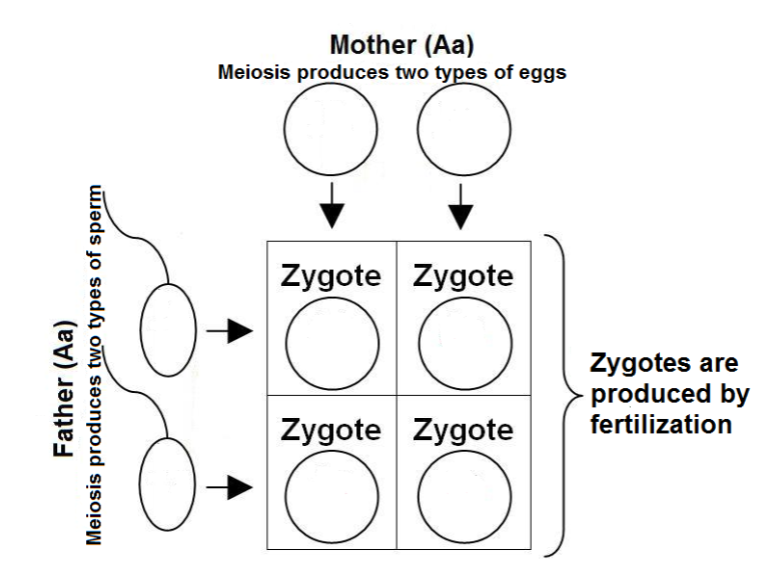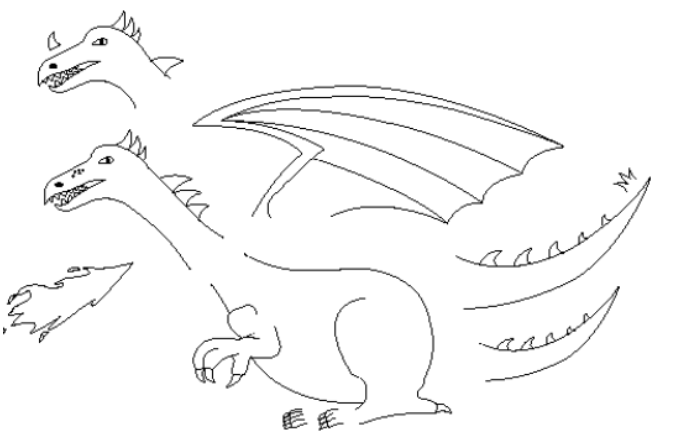5.2: Dragon Genetics Protocol (Part 2)
- Page ID
- 25104
Introduction
In this activity, you and a partner will work together to produce a baby dragon. You will simulate meiosis and fertilization, the biological processes by which the parents' genes are passed on to a baby. To begin, we will review meiosis and fertilization for dragons that have only one chromosome with a single gene.
This gene codes for the enzyme that makes the pigment that gives dragon skin its color.
- The dominant allele, A, codes for a normal enzyme that results in normal skin color.
- The recessive allele, a, codes for a defective enzyme that cannot make skin pigment, so an 'aa' dragon is an albino with completely white skin.
★ Suppose that each dragon parent has the pair of homologous chromosomes shown.
Father Mother
A___ A___
a___ a___
Draw the chromosomes of the two types of eggs and the two types of sperm produced by meiosis. Then, draw the chromosomes of the zygotes that are produced when the different types of sperm fertilize the different types of eggs. Next, use an asterisk (*) to indicate any zygote or zygotes that will develop into albino baby dragons.

In this activity, you will work with a partner to carry out a simulation of meiosis and fertilization and produce a baby dragon. Each student will be a surrogate dragon parent who has the genes indicated on a set of three Popsicle sticks. Each side of a Popsicle stick represents one chromosome, and the two sides together represent a pair of homologous chromosomes. This table explains how the simulation mimics the biological processes of meiosis and fertilization.
| Biological Process | Simulation |
|---|---|
|
The parents' diploid cells have pairs of homologous chromosomes. Meiosis separates each pair of homologous chromosomes, so each gamete receives only one from each pair of chromosomes. Thus, the parents' diploid cells have two copies of each gene, but each haploid gamete has only one copy of each gene. |
Each dragon parent drops his or her Popsicle sticks on the table or desk, and the side of each Popsicle stick that is facing up indicates which chromosome from each homologous pair is included in the gamete. The alleles from this chromosome are recorded in the Egg or Sperm column in the charts on page 4. |
|
When a haploid sperm fertilizes a haploid egg, this produces a diploid zygote with one copy of each gene from the mother and one copy from the father. These genes determine the phenotypic traits of the baby dragon that develops from this zygote. |
The dragon parents record the phenotypic traits of their baby in the Baby's Traits column in the charts on page 4. |
Simulation Procedure
1. Choose a partner carefully. You and your spouse will share the grade for this lab. Your instructor does not care which partner worked the hardest. This is a no divorce classroom. The lab must be completed on time.
2. Each partner must pick up a bundle of three Popsicle sticks -- one green autosome, one yellow autosome, and one sex chromosome stick. Parent partners must be of the opposite sex; therefore one parent must pick up a bundle with a double X chromosome Popsicle stick (red) and the other must pick up a bundle with an X/Y chromosome Popsicle stick (blue).
3. Record the alleles from both sides of each Popsicle stick for Mom in the first column of the charts on page 4 and the alleles from both sides of each Popsicle stick for Dad in the second column.
4. Use the decoding chart on page 3 to figure out the phenotypic effects of each parent’s genes. Record Mom's and Dad's phenotypic traits in the last two columns of the charts on page 4.
5. For each color autosome and then for the sex chromosomes, each parent will randomly drop his or her stick on the table or desk. The side of the stick that is up represents the chromosome that is passed onto the baby via meiosis and fertilization. Record the alleles from this chromosome in the Egg or Sperm columns in the charts on page 4.
6. Next, you must decode the genes inherited by your bundle of joy to determine the phenotype of your baby. Record the trait produced by each pair of alleles in the Baby's Traits column of the charts on page 4. If your baby dragon is aa, be sure to take this into account when assessing the phenotypic effects of the skin color and freckles genes.
7. Using the pictures at the end of this handout, cut out the traits and paste them together to create a picture of your baby. If you prefer, you may trace the traits to produce your baby’s picture. If your baby dragon has them, draw in extra toes, freckles and/or skin color (or label the color).
| Chromosome | Dominant Alleles | Recessive Alleles |
|---|---|---|
| Green Chromosome |
W = Has Wings L = Long Neck and Tail A = Normal Skin Pigment C = Skin Color Dark Green* |
w = No Wings l = Short Neck and Tail a = Completely White, Including No Freckles c = Skin Color Light Green* |
| Yellow Chromosome |
F = Fire-breather T = [see below] R = [see below] |
f = Not a Fire-breather t = [see below] r = [see below] |
|
X Chromosome |
H = Has Horn on Nose | h = hornless |
| Y Chromosome | M = Male Sex (Results in Spike on Tip of the Tail) | |
|
Incompletely Dominant Alleles TT = five-toed Tt = four-toed tt = three-toed RR = Lots of Freckles (Draw 10) Rr = Some Freckles* (Draw 5) rr = No Freckle *If a dragon is aa and therefore unable to make skin pigment, it will have white skin and it will not have any freckles (no matter what alleles it has for the skin color and freckles genes). |
||
Our Baby!
Names____________________________________________________________ ____________________________________________________________
Green Autosomes
| Genotypes | Alleles in | Phenotypes | ||||
|---|---|---|---|---|---|---|
| Mom | Dad | Egg | Sperm | Baby's Traits | Mom's Traits | Dad's Traits |
Yellow Autosomes
| Genotypes | Alleles in | Phenotypes | ||||
|---|---|---|---|---|---|---|
| Mom | Dad | Egg | Sperm | Baby's Traits | Mom's Traits | Dad's Traits |
Sex Chromosomes
Use the first line for the alleles on the X chromosomes and the second line for the allele on the Y chromosome. Remember that the sperm will have either an X chromosome or a Y chromosome.
| Genotypes | Alleles in | Phenotypes | ||||
|---|---|---|---|---|---|---|
| Mom | Dad | Egg | Sperm | Baby's Traits | Mom's Traits | Dad's Traits |
| None | None | No Spike on Tip of Tail | ||||
Use the baby's phenotypic traits and the figure on the last page of this handout to make a picture of your baby dragon. If your baby dragon has them, draw in extra toes, freckles and/or skin color (or label the color).
Questions
1a. What is one phenotypic trait that is the same in Mom, Dad and baby dragon?
1b. Draw a Punnett square to show how your baby dragon inherited the genes that resulted in this trait. In the Punnett square, circle the genotype of your baby dragon.
1c. Suppose that Mom and Dad had a second baby. Would the second baby necessarily have this same trait? Explain why or why not.
2a. Does your baby dragon have exactly the same phenotypic traits as his or her same-sex parent?
2b. If not, choose one trait that differs between the baby and the same-sex parent and explain the genetic reason for this difference.
3a. What is Mendel's Law of Segregation?
3b. Explain how Mendel’s Law of Segregation is simulated by dropping a Popsicle stick and writing the letters on the side facing up in the egg or sperm column of the charts on page 4.
3c. Use an example from this simulation to demonstrate how segregation of two alleles during meiosis, followed by fertilization, can result in a baby that has a new phenotypic trait that is not observed in either parent.
4a. What is Mendel's Law of Independent Assortment?
4b. Explain how Mendel’s Law of Independent Assortment is simulated by dropping the green and yellow autosome Popsicle sticks.
4c. Explain why the Law of Independent Assortment does not apply to genes that are close together on the same chromosome.
5. This simulation can be thought of as a simplified model of how meiosis and fertilization result in inheritance. Like all models, this simulation is not a completely accurate model of biological reality. For example, in this simulation, a gamete receives all of the genes on one chromosome from each homologous pair and none of the genes on the other homologous chromosome. Explain why this is not an accurate model of biological reality. Explain how meiosis can result in a chromosome in the gamete that has parts of both chromosomes in a parent’s pair of homologous chromosomes.
6a. For the mom and dad in the simulation, will all of their daughters have horns? Explain why or why not.
6b. For this couple, will all of their sons have horns? Explain why or why not.
6c. Which sex will be more likely to have horns. How might horns be an advantage for this sex? [Be creative in your answer.]
7. Use the decoding chart on page 3 to complete the following table.
|
Phenotypic Trait |
Can two individuals with this phenotype have different genotypes? If yes, give an example of the different genotypes. |
| Has Wings | |
| Has Five Toes | |
| Has No Freckles |
8a. What is epistasis?
8b. Describe an example of epistasis in this simulation.
8c. Explain the molecular basis for this example of epistasis. (Hint: Review the top of page 1.)
9. Phenotypic traits are influenced by environment as well as genotype. Propose an environmental factor that might influence phenotypic traits as the baby dragon grows up, e.g. how long the neck and tail grow or how dark the freckles in the skin become.



